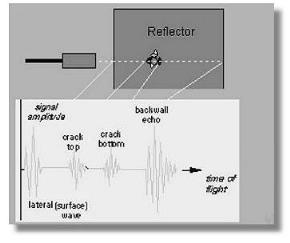 Ultrasonic inspection of parts involves transmission of ultrasonic waves through the material. In the reflection technique, a sound wave is transmitted from one side of the sample, reflected off the far side, and returned to a receiver located at the starting point. Upon impinging on a flaw or crack in the material, the signal is reflected and its traveling time altered.
Ultrasonic inspection of parts involves transmission of ultrasonic waves through the material. In the reflection technique, a sound wave is transmitted from one side of the sample, reflected off the far side, and returned to a receiver located at the starting point. Upon impinging on a flaw or crack in the material, the signal is reflected and its traveling time altered.
The actual delay becomes a measure of the flaw's location; a map of the material can be generated to illustrate the location and geometry of the flaws. In the through-transmission method, the transmitter and receiver are located on opposite sides of the material; interruptions in the passage of sound waves are used to locate and measure flaws. Usually a water medium is employed in which transmitter, sample, and receiver are immersed.
Sokolov described another important concept in ultrasonic applications, the ultrasonic Microscope. He demonstrated that sound waves could be used as a new form of microscope. Sokolov recognized that a microscope using sound waves with a frequency of 3,000 megahertz (MHz) would have a resolution equal to that of the optical microscope. Since then, however, the technology was progressively developed, and the high frequencies required for Sokolov's microscope are found in microwave and ultrasonic systems used for radar.
He described in 1937 the Sokolov tube used for underwater imaging, where an acoustical image of an object comes into view as result of object "illumination" by two ultrasonic transducers. The device was also known as the Acoustic Electron-Ray Converter (AERC). It consisted of a specially developed Piezoelectric Element Matrix (PEM) lens made from a piezoceramic disk where grooves are cut into the lens surface at a depth of about 2/3 plate thickness, making about 1000 square elements with sides of 1 mm. Each element is electrically connected with a glass-metallofiber faceplate of vacuum cathode-ray tube or Cathode-Ray Converter (CRC). The electrical potential distribution on the back surface of the PEM is carried to the inner surface of the CRC. An electron beam scanning this surface converts the electrical image into a time dependent output signal that can be processed and displayed as an image. The system has being designed to have minimal geometric distortions, taking into consideration the diffraction spot diameter and piezoelements' size. (Sokolov, S.Y.- US Pat.2164125 (1937)). In 1955, the first successful experiments were carried at the Andreev`s Acoustical Institute, Moscow, Russia.